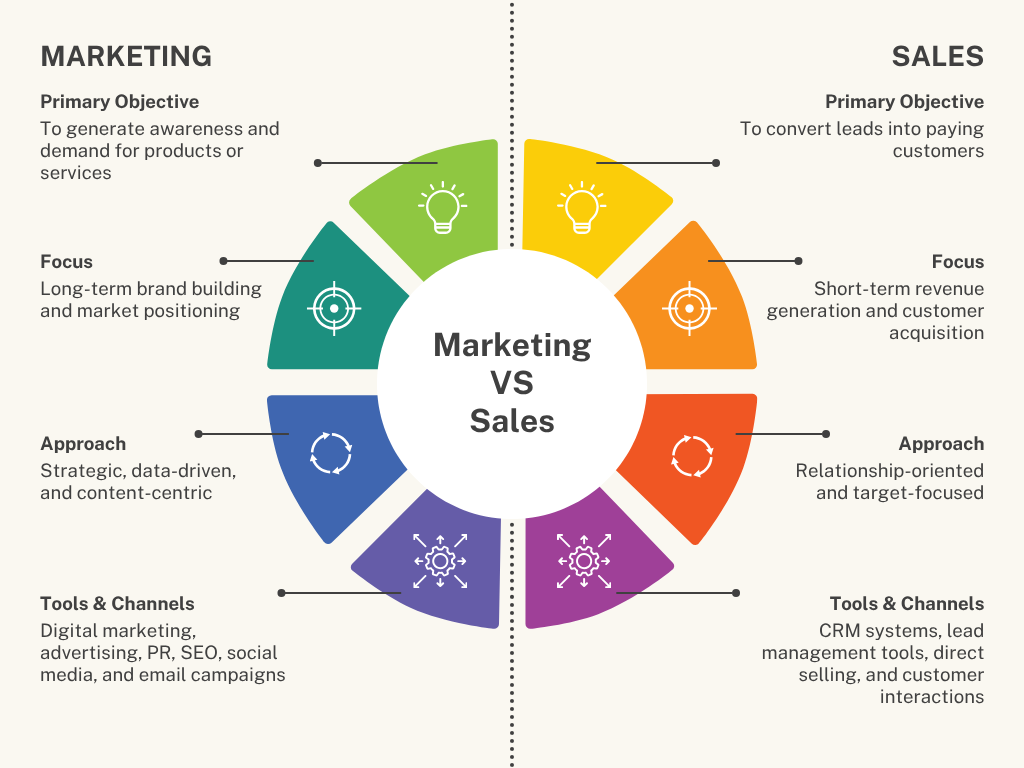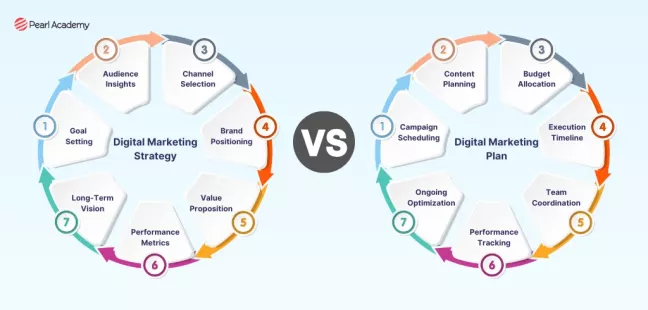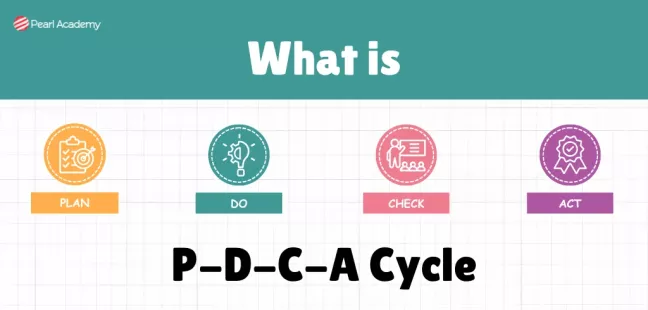Sales and Marketing: Why Businesses Need Both to Succeed
- Editorial Team
- Published 19-Oct-2025

In today’s highly competitive global economy, Sales and Marketing are not merely business functions; they are the twin engines that determine an organisation’s growth, profitability, and sustainability. While marketing builds awareness, establishes brand identity, and nurtures leads, sales converts that awareness into revenue. Without the balance of both, even the most innovative companies struggle to scale.
This blog explores the crucial interdependence between sales and marketing, their differences, roles in various business models, success measurement frameworks, and the evolving career landscape in both domains.
Become future-ready with our Business Programs
Know MoreDifference Between Sales vs Marketing
Though often used interchangeably, Sales and Marketing serve distinct yet interconnected purposes within a business ecosystem.
| Aspect | Marketing | Sales |
| Primary Objective | To generate awareness and demand for products or services | To convert leads into paying customers |
| Focus | Long-term brand building and market positioning | Short-term revenue generation and customer acquisition |
| Approach | Strategic, data-driven, and content-centric | Relationship-oriented and target-focused |
| Time Horizon | Continuous process focused on market expansion | Goal-based process focused on meeting quotas |
| Tools & Channels | Digital marketing, advertising, PR, SEO, social media, and email campaigns | CRM systems, lead management tools, direct selling, and customer interactions |
In essence, marketing attracts potential customers, and sales transforms them into loyal buyers. Successful organisations integrate both functions to ensure the customer journey remains consistent from awareness to post-purchase experience.

Sales vs Marketing in B2B vs B2C
The interplay between Sales and Marketing varies depending on whether a company operates in a B2B (Business-to-Business) or B2C (Business-to-Consumer) environment.
B2B Context
- Longer Sales Cycles: B2B deals often involve multiple decision-makers and require extensive nurturing.
- Relationship-Centric: Marketing focuses on thought leadership, content marketing, and account-based marketing, while sales depend on building trust through consultations and demonstrations.
- Example: A SaaS firm might use whitepapers and webinars to educate leads before the sales team conducts demos to close enterprise clients.
B2C Context
- Shorter Conversion Journeys: Consumers make quicker purchasing decisions based on emotions, price, and convenience.
- Marketing-Driven Awareness: B2C marketing leans on storytelling, influencer campaigns, and social media engagement to build desire.
- Example: A fashion brand runs targeted Instagram ads to generate traffic, while the sales function ensures efficient e-commerce transactions and after-sales service.
The synergy between sales and marketing in both cases is essential. B2B needs structured alignment for lead nurturing, whereas B2C demands agility and creativity to influence buyer behaviour.
Roles, Strategies, and Key Functions Explained
Let us understand in depth the difference between the roles in sales and marketing. Read below to know more:
1. Roles in Sales
Sales professionals focus on converting interest into transactions. Their key functions include:
- Prospecting and qualifying leads
- Conducting product demonstrations or consultations
- Negotiating and closing deals
- Managing client relationships and renewals
2. Roles in Marketing
Marketing professionals aim to build and sustain brand relevance. Their key functions include:
- Market research and segmentation
- Campaign planning and execution
- Branding, content creation, and communication design
- Performance tracking using analytics and KPIs
3. Strategic Integration
When Sales and Marketing collaborate effectively, organisations experience:
- Higher lead-to-conversion ratios
- Improved customer retention and satisfaction
- Streamlined communication and resource allocation
Example:
According to HubSpot, companies with strong sales-marketing alignment achieve 208% higher marketing revenue and 36% better customer retention rates.
How to Measure Success in Sales and Marketing
Success in Sales and Marketing is measured through quantitative and qualitative indicators that reflect performance, efficiency, and growth.
Marketing Metrics
- Brand Awareness: Measured by reach, impressions, and brand recall surveys.
- Lead Generation: Evaluated through website traffic, conversion rates, and MQLs (Marketing-Qualified Leads).
- Engagement: Social media interactions, click-through rates, and content shares.
- Return on Marketing Investment (ROMI): Revenue attributable to marketing spend.
Sales Metrics
- Revenue Growth: Total sales volume and growth rate over a specific period.
- Lead Conversion Rate: Percentage of qualified leads converted to customers.
- Customer Retention Rate: Ability to retain clients through repeat purchases.
- Sales Cycle Length: Average time taken to close deals.
Integrating these metrics provides a holistic view of business performance, allowing organisations to refine both their outreach and conversion strategies.
Salaries, Growth, and Career Paths in Sales and Marketing
The demand for professionals in Sales and Marketing continues to rise globally, driven by digital transformation, e-commerce expansion, and data analytics.
Average Salary Range
| Role | Entry Level (₹/year) | Mid-Level (₹/year) | Senior Level (₹/year) |
| Marketing Executive | ₹3–6 lakhs | ₹6–12 lakhs | ₹15–25 lakhs |
| Digital Marketing Manager | ₹5–8 lakhs | ₹10–18 lakhs | ₹20–35 lakhs |
| Sales Executive | ₹3–5 lakhs | ₹6–10 lakhs | ₹15–30 lakhs |
| Key Account Manager | ₹5–8 lakhs | ₹10–20 lakhs | ₹25–40 lakhs |
| Brand Manager | ₹7–12 lakhs | ₹15–25 lakhs | ₹30–45 lakhs |
Information Source: Glassdoor, PayScale, Indeed
Career Growth Opportunities
- Marketing Pathways: Digital marketing strategist, brand manager, media planner, product marketing manager, CMO.
- Sales Pathways: Business development manager, key account director, regional head, VP of Sales, CRO.
- Cross-Functional Roles: Many professionals transition into marketing analytics, growth strategy, or sales enablement functions.
Why Businesses Need Both Sales and Marketing to Succeed
Businesses need both sales and marketing to succeed because each function fulfils a distinct yet complementary role in driving growth. Marketing builds awareness, generates interest, and positions the brand in the minds of potential customers through strategic communication, market research, and digital outreach. Sales, on the other hand, transforms that awareness into tangible results by engaging prospects, addressing their needs, and converting them into paying customers.
Without marketing, sales teams would lack qualified leads and brand credibility; without sales, marketing efforts would not translate into revenue. When aligned, the two create a seamless customer journey, from discovery to purchase and beyond, ensuring consistent brand experience, higher conversion rates, and long-term customer loyalty. In essence, marketing fuels demand, while sales fulfils it, making their collaboration essential for any business to sustain and scale effectively.
Future Outlook
The Indian digital marketing sector is projected to grow at over 25% annually, while global sales roles are rapidly evolving toward consultative and data-assisted selling. This convergence ensures exciting and diverse opportunities for professionals trained in both disciplines.
Those interested in making a career in marketing, can choose to enrol in BBA specialisations offered at Pearl Academy. With global exposure, industry partnerships, robust placements, and other benefits of an accredited degree, launch your career to new heights. Apply Today!

Student Guidance Center: Our Counselors are Just a Click Away.
Conclusion
The interplay between Sales and Marketing defines an organisation’s capacity to attract, convert, and retain customers. Marketing creates demand, sales capture it, and both together fuel profitability and brand equity. Businesses that align these two functions strategically not only experience faster revenue growth but also achieve stronger customer loyalty and market differentiation. In the modern marketplace, success lies not in choosing between sales or marketing, but in mastering both.
Tags
- #Business
Pearl Admission Enquiry
Subscribe to Pearl Blogs
By clicking the "Subscribe" button, I agree and accept the privacy policyyy of PEARL.



















































